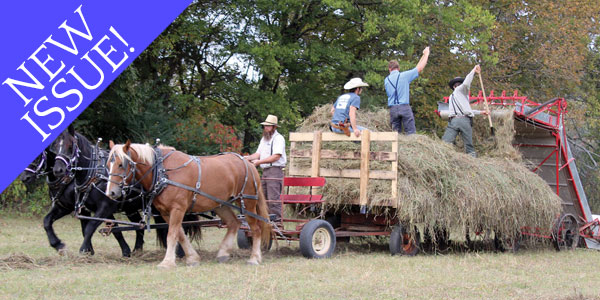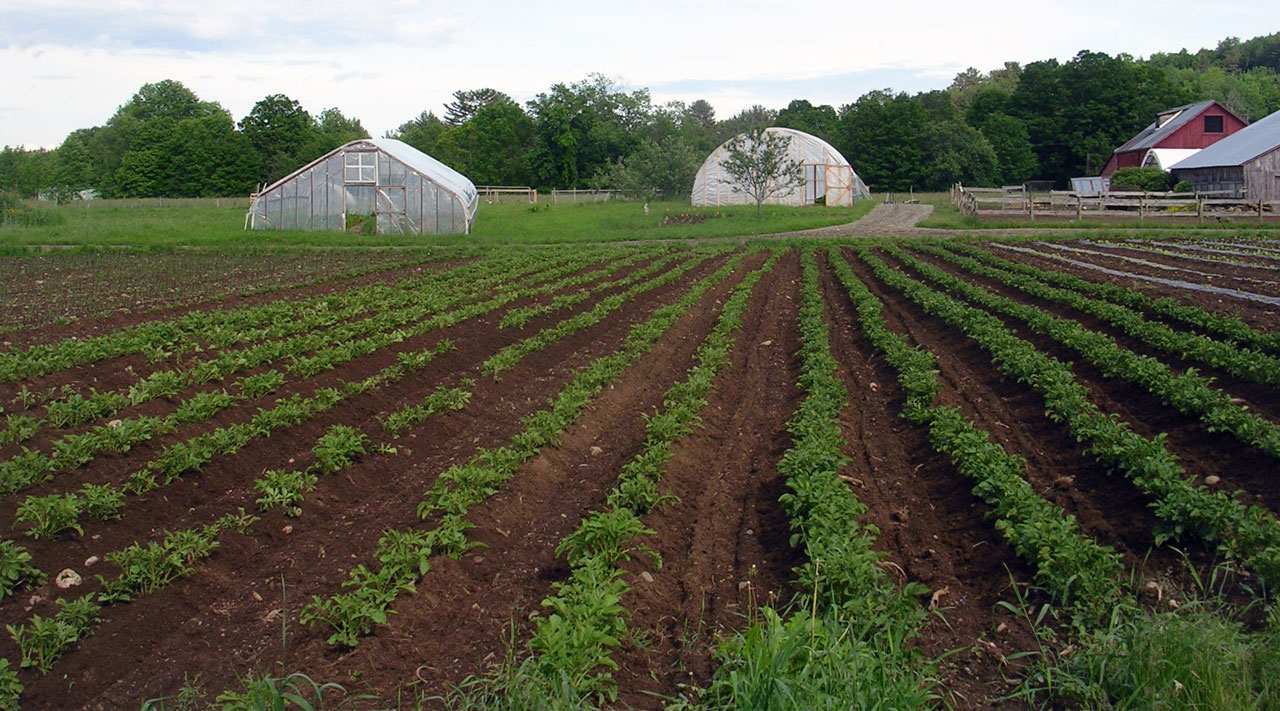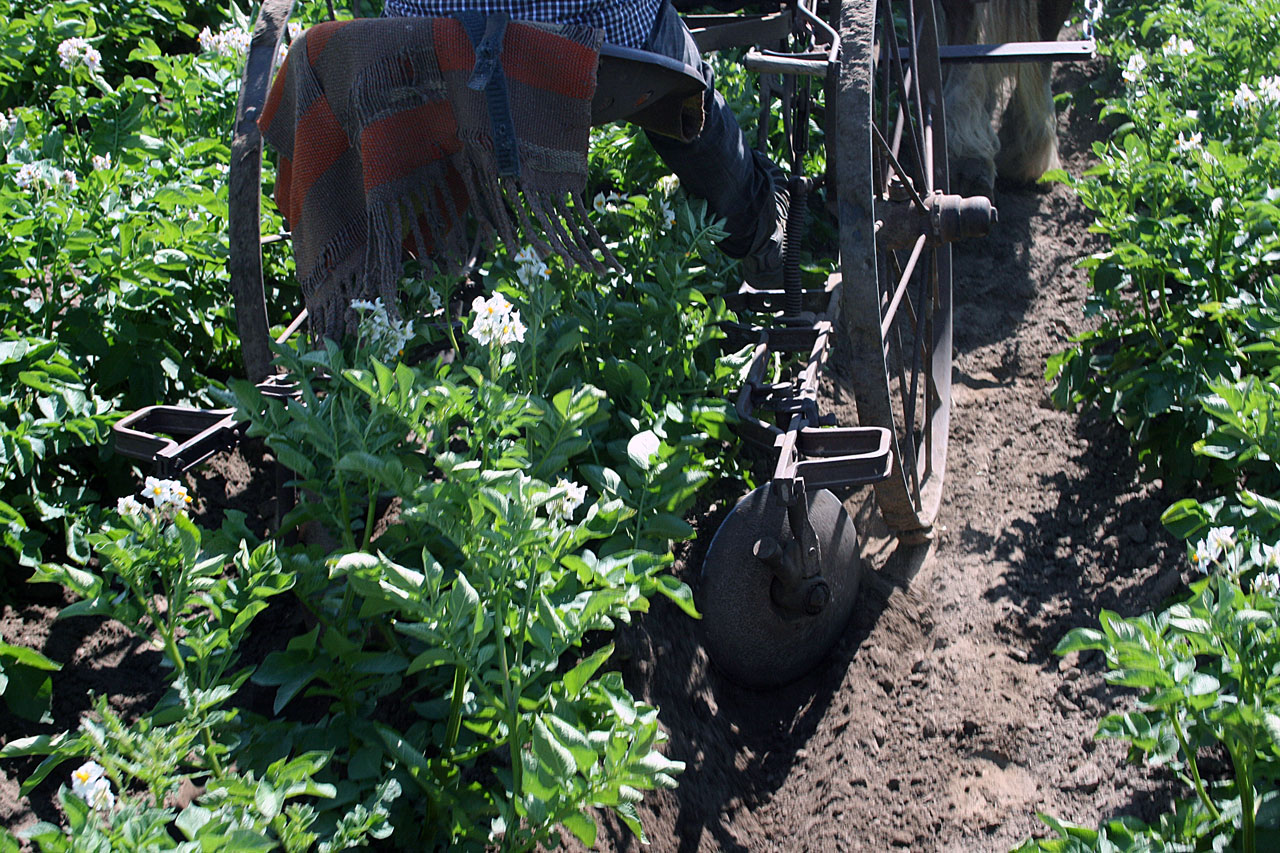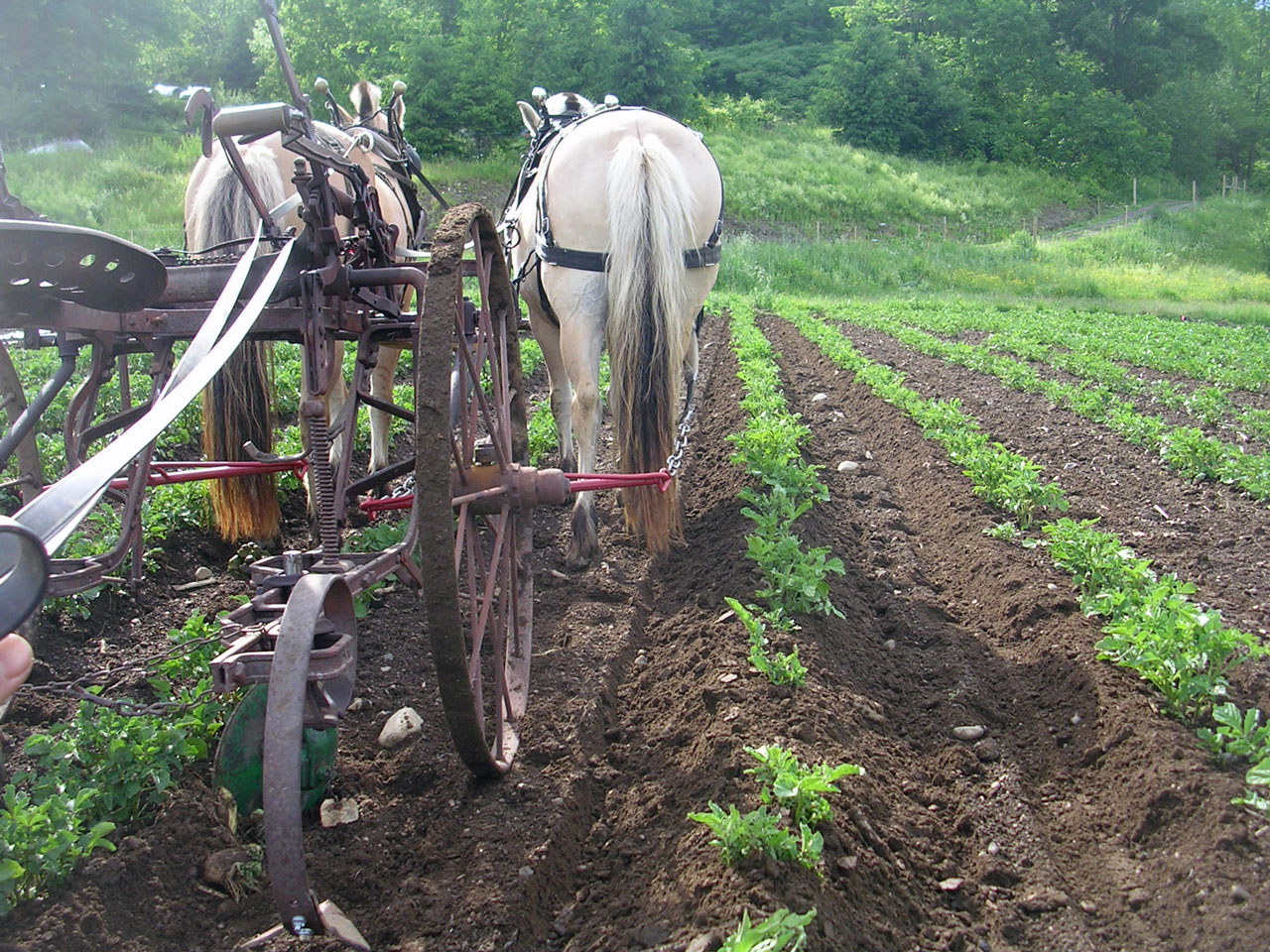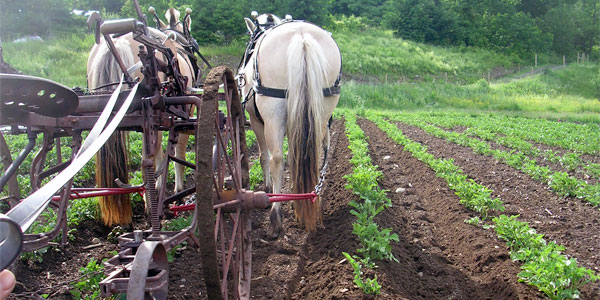
Fjordworks: Horse Powered Potatoes Part 1
Fjordworks: Horse Powered Potatoes
by Stephen Leslie with technical assistance provided by Kerry Gawalt, both of Cedar Mountain Farm at Cobb Hill co-housing in Hartland, VT.
PART ONE
Introduction
This is the account of how one farm put more horse power into the planting, cultivation, and harvesting of its potato crop. Ever since we began farming on our own in 1994 one of our principle aims has been the conversion of our farm operation to live horse power wherever feasible. This has meant replacing mechanized tools such as tractors and rototillers and figuring out how to reduce human labor as we expanded upon the labor capacity of our work horses. The first year that we graduated from being apprentices to managing our own market garden we employed two Haflinger horses to the best of our greenhorn ability. On a 1/2 acre plot of potatoes the Haflingers helped to prepare the ground for planting by pulling a spike tooth harrow, and later they each took turns pulling a single horse drawn middle buster-type implement to hill the crop. This relative early success utilizing horse power inspired us on a quest to achieve 100% horse and human power to manage our market garden. This proved to be a long road with many exhilarating leaps forward and some daunting set-backs. The evolution of our potato growing method (still a work in progress) is a case in point.
The potato is a preeminent member of the nightshade family (Solanaceae). The only edible portion of the plant is the starchy, nutritious tuber. The potato was first cultivated in the Andes region some 7,000-10,000 years ago where it became a staple food of the Incan Empire. It is now an essential staple food across the Americas, Europe, and increasingly in Asia, with nearly 1/3 of the world’s annual crop being grown in China and India. The leaves, shoots, flowers, and berries of the potato plant contain noxious alkaloids that can cause severe poisoning and even death when consumed in sufficient quantities—but as long as the tubers are not exposed to direct sunlight (greening) they contain insignificant amounts of these toxins. In the Andes hundreds of regional varieties were developed. When the potato was brought to Europe a relatively limited number of cultivars were introduced. The potato quickly became an important crop and was partially responsible for the accelerated population boom that occurred in Europe between 1700-1900 (although it may not be ideal, a combined diet of potatoes and cow’s milk contains enough protein, starches, vitamins and minerals to sustain a healthy human). However, the limited number of varieties initially introduced left the crop vulnerable to disease, particularly fungi such as the late blight that was the ostensible cause of the horrific famine years in Ireland beginning with a near complete crop failure in 1845.(1)
Planting Potatoes with a Single Horse Plow
Most, if not all, commercial growers buy in seed potatoes to grow their crop. Seed potatoes have been cultured to insure your crop will be disease free (and more resistant to disease) at the outset. In other parts of the world farmers still save their own seed potatoes, with the advantage of developing regionally adapted varieties. Home gardeners and some commercial growers cut their seeds into pieces (with two or three “eyes”—sprouts—per piece) and cure them spread on tarps or a barn floor for 24 hours prior to planting. We have found it economical and time-efficient to plant uncut potatoes. We feel the plants get off to a better start with the extra energy boost of a whole seed. Within our annual garden rotation potatoes follow onions. The onions are usually harvested by mid-late August which gives us plenty of time to establish a catch crop of oats or rye in what will become the potato ground. In the spring we will give this ground a moderately deep plowing to make the soil friable for spuds and then after discing we spread it with finished compost at a rate of about 9-10 tons/acre (in actuality for this season the field was spread at this rate in both the fall and the spring for a total of 18-20 tons/acre—we applied at this rate because we had so much rain—9” from Hurricane Irene in a 24 hour period on August 29th, followed by a very wet fall—that we were concerned about excessive nutrient leaching in our highly porous soils). Next, the field was disced again, harrowed with a spring tooth, and smoothed with a flex harrow.
For moderately deep plowing we hitch the Fjords to a 14” Pioneer walking plow. For the discing we use a 6’ single action disc pulled behind a forecart, and for harrowing we also pull a single 3’ spring tooth section and a 5’ flex harrow behind the cart. For delivering the compost we are using a John Deere “H” series single axle spreader (again, hitched to the forecart) which has an approximate 60 bushel capacity.
At this point the plot is ready to be marked out with rows. Although in general our row crops are planted at 32” we plant the potatoes on 36” to account for the wheel base of our digger. The basic recommendation for spacing for potatoes is 18” between rows and 18” between plants in the row. On 36” row spacing we reduce the space between plants in row to one foot. We used to mark out the rows by hand—using a Gallagher reel and polywire to create a guide for a first straight row followed by a human pulled three-tined marker to trace out the rows. This method insured uniform rows but was quite human labor-intensive, taking one person at least one hour to accomplish. This year we came up with a system for marking out the rows with the horses by using a tool bar mounted on a manual three-point hitch adapter on the forecart. The tool bar is set up with two shanks as markers and a third “boom arm” out to the side of the near-horse in order to trace a mark for the off-horse to follow for marking out successive rows. With this method the rows in a 1/4 acre section can be marked out with the team in about 1/2 hour. Often times in the spring during the big push to get the crops seeded or transplanted it is practical to mark out two or more sections at once, greatly enhancing the efficiency of the horse drawn marker.
Once the rows are marked the next step is to create planting furrows. About eighteen years ago we acquired a vintage single horse plow with a 10” bottom that was just the right size for our smaller draft horses. It is stamped as a Hillsdale no. 19 from a foundry that once existed in Columbia County, New York. For plowing smaller acreage the single horse drawn plow still presents a viable option. The single plow can also find utility on the farm for working up ground in tight spaces such as inside a hoophouse, or close to its outside walls, and alongside fence lines, perennial plantings, etc. A heavy draft horse can pull a 12” bottom plow and handle the work of a small to mid-size market garden (1-5 acres). The majority of plows specifically designed for the single horse are in the 8”-10” bottom range. The beam of the plow is centered slightly more over the share than in a team plow (on many single plows this is an adjustable factor that will affect furrow width). The single horse will walk on the unplowed ground directly ahead of the plow. Our oldest mare works on both the single horse and team walking plow. There is a bit of irony involved in training a horse that is used to walking in the furrow to step out and walk ahead of the plow, but a good work horse will have the mental agility to deal with the switch. I always keep in the back of my mind that if one of our horses should be temporarily side-lined with lameness or illness, I could still get out and do some plowing with this single horse plow, rather than having to resort to the tractor.
Initially we used this plow with a team when we were working with young horses for which our 14” bottom plow presented too much challenge. Once they were able to graduate to the larger plow, we reserved the use of the single plow to setting furrows to plant out potatoes. To do this we mark out the rows beforehand at 36” spacing. We employ our older steady mare to draw the plow, with one person driving and the other with hands on the plow. In this way we can set a straight furrow of consistent depth (about 5”) just right for planting spuds.
Other common options for creating a planting furrow on horse powered farms involve using a furrower attachment. Such an attachment can be custom designed by outfitting a riding cultivator with a central shank (as first demonstrated by Anne and Eric Nordell), or by using a three-point hitch adapter on a forecart with a furrower attachment. I&J Mfg. makes a three-point hitch (with either manual or hydraulic lift) that fits onto their own forecart or onto the basic Pioneer forecart, and they have a furrowing attachment to use with this hitch (along with an array of other tillage tools). The new Homesteader multi-tool carrier from Pioneer Equipment also has the option of a center-mounted furrowing tool (both of these tool carrier set-ups also have middle-buster/potato plow and disc hiller/ridger options useful for potato cultivation). A potential advantage of all these systems over our single plow method would be the possibility of marking out the rows and creating the planting furrow all in one pass. Yet another option is to set up the rear center shank of a walk behind cultivator with a furrowing shovel.
When it comes time to actually getting the seed potatoes into the ground, a potato planter can be useful in a larger market garden. Ground driven potato planters were routinely employed on horse powered farms of yesteryear and these machines can often be found in good working order (Issac Hoover, inventor of the potato digger discussed in part two of this article, also designed and manufactured the first single row potato planter in 1915—ground driven potato planters are still being manufactured but as far as I am aware these are all three-point- hitch mounted machines instead of the original riding model). The ground driven potato planter picks seed from a hopper, opens a furrow, drops the seed in at the desired spacing, and covers all to a uniform depth. The choice to acquire a planter will probably be dependent on scale. But generally speaking, it is a plus both in terms of farm economics and in terms of keeping the horses fit any time they can be efficiently hooked to an implement to accomplish a task in the field that would otherwise be accomplished by human labor. Along with the digger, the invention of the potato planter made the growing of potatoes a much more profitable proposition by significantly lowering human labor costs of production.
The potato qualifies as a “cool season” plant in that its growth is curtailed if soil temperatures exceed 80 degrees. We try to time the potato planting so that by the time the plants emerge from the ground we will be past the risk of hard frost (May 20th in our region). The potato foliage can withstand a light frost but a hard frost or freeze will really set them back. In Southern Vermont (Zone 4) an early planting time for potatoes is late April to the 1st week of May. We also find that planting the potatoes early capitalizes on the higher soil moisture of the spring season and helps to get a little jump on the emergence of the Colorado Potato Beetle. This beetle is indigenous to Colorado where it fed on the Buffalo Bur, a distant cousin of the potato. From the time European settlers came into the territory in 1859 the beetles began their own inexorable migration eastward; to anywhere the potato will grow. The only thing we have found that the CPB loves more than potatoes is eggplant, which we grow under floating row cover until the plants reach flowering stage and require the attentions of bees (some growers will put a row of eggplant alongside the potatoes as a “trap” crop). In bad years we have seen the beetles move onto the tomatoes after they have laid waste to the potato patch. The adult beetles over-winter in soil and plant detritus and then crawl out in search of feeding grounds (a hard winter will significantly reduce their numbers). Even in a market garden following an annual crop rotation it doesn’t take the newly emerged CPBs long to find the next potato patch. These over-wintered adults don’t present too much of a problem in terms of leaf chewing, their main objective is copulating and laying eggs (bright yellow-orange clusters on the undersides of leaves). It is the juvenile “grub” stage of the beetle that presents a real threat to your crop. If the plants are otherwise growing well they can withstand about 30% defoliation but anything beyond that will negatively impact yields. If your potato patch is on a small scale, a reasonable first line of defense is to go through on a daily basis to pick off the first wave of adult beetles by hand.
At present, we set out our potatoes by hand. Through the Farm to School Program our farm plays host to 3rd grade students from the local elementary school and we have found planting potatoes to be a successful activity with which to engage them (see article on Farm to School in SFJ Fall 2011). The children are paired in teams with a bucket of spuds and a measure stick. With a little bit of adult supervision kids this age are willing and able to handle this task. We then cover the potatoes using garden rakes. If we weren’t using the potato planting as a “teaching opportunity” we could use our single horse plow to cover the potatoes by going down in reverse direction alongside the planting furrows.
Cultivation and Hilling
A few days after we planted the potatoes this season (2012) we received a good spring rain shower and the next day when the sun broke through the clouds the potato section was covered in a fine green carpet of newly sprouted weeds. In the past we had dealt with this kind of early bloom by going through the patch with the single horse cultivator. At planting time we would place marker flags at the top and bottom of each row so that we could navigate the row paths without fear of unearthing the newly planted spuds. The walk-behind cultivator will throw some dirt sideways onto the planted row to help cover tiny weeds, but some weeds do survive in row with this method and have to be hoed out by hand once the potatoes have begun to emerge. This year we decided to try “blind cultivation” for a more thorough weed eradication. We ground drove the team hitched to a single section of flex (pasture) harrow over the entire area. The weeds were at “white thread” stage and the harrow worked perfectly for uprooting them. The chipping action of the horse’s hooves knocked about two dozen seed potatoes out of the ground. We went back afterwards and re-planted them—a small price to pay to eliminate hand-hoeing later on. Another option for blind cultivation is to mount a Lely Weeder (a tine-weeder) on a forecart with a three-point hitch (there are some horse powered market gardeners who have adapted riding cultivators to accept the Lely Weeder as an attachment).(2)
Once the potatoes were up, but before they were big enough to withstand hilling, we went through the section twice with a riding cultivator set up with standard 1 3/4” shovels to keep the weeds at bay (twice over a 10 day period). The shovels of the riding cultivator will throw more dirt onto the crop row but still not enough to hill the potatoes or cover all sprouting weeds. At this point the row paths were clean but the weeds were beginning to take hold among the young potato plants. Also, probably because we had an especially soft winter, the Colorado potato beetles were already present and getting down to business. We didn’t have much time for hand-picking of beetles but we began scouting every day for the 1st crop of beetle grubs because it is at the larval stage that the CPB is most susceptible to organic pesticide. Once the juveniles have emerged we spray a spinosad product (an organically accepted pesticide that like Bt. must be ingested by the targeted insect) on the foliage with a backpack sprayer.(3)
Another option for spraying used on some contemporary horse powered farms is to employ a boom sprayer. On an organic or ecological operation the boom sprayer can be used for applying accepted soluble pesticides on a variety of crops, such as Dipel on Brassica (a B.t. control for loopers) and Pyganic for flea and cucumber beetles and other pests (a pyrethrum). In addition, the boom sprayer is very useful for applying soluble fertilizer to the soil and foliar fertilizer to leafy crops (and for the “preparations” on Biodynamic farms). This is a tool that has made it onto our (long) equipment wish-list, however for applying a pest control such as a pyrethrum product (which is a “blanket-killer”) we prefer the very specific application to affected plants that can be made with the backpack sprayer because we feel there will be less impact on beneficial insects. Again, this will be a choice affected by the scale of your operation—spraying a 1/4 acre of potatoes with the backpack sprayer is a good hour of exercise but spraying 5 acres of potatoes with this method would become an all-day chore.
Hilling potatoes serves several purposes at once. Just like its distant cousin the tomato, the stem of the potato “vine” will sprout more stolons when it is buried, potentially increasing the yield of tubers. As mentioned, a timely hilling will bury tiny weeds in the row path, and oftentimes by the end of a 2nd or 3rd hilling the plants will have put on sufficient foliage to shade out new weeds from sprouting in row. Hilling will also build up the potential soil moisture bank for the tubers to draw on, but perhaps most importantly it will shield the shoulders of the developing tubers from the “greening” effect that comes from exposure to sunlight. On a home garden scale hilling can also be accomplished by applying a mulching material such as straw, waste hay, or leaves.
We commit one section within our market garden rotation to potatoes each year. The sections in our garden are roughly a 1/4 acre (60’x200’—though they vary in length and width as our garden is more of a wedge shape than a rectangle). A potato section of this size can be very effectively hilled with a single-horse drawn hiller (variously known as a middle-buster or potato plow). This tool is constructed with what appears to be two opposing plow shares joined at the tip to create a large goosefoot mounted below a beam with a clevis hitch for a single tree and with handles identical to those found on a walk behind cultivator. We had one of these on loan for a season and found it to be an exceptional tool for cultivating and hilling the spuds. But after we had to return that particular tool we searched in vain for a replacement. In the meantime, we had resorted to using large hand-held hoes to hill our spuds. After seeing a photo in SFJ of some Pennsylvania horse farmers hilling potatoes with a riding cultivator set up with disc hiller attachments we decided to try and go that route.
We were lucky to have recently acquired a 2nd McCormick-Deering cultivator from a neighbor who runs a scrap metal salvage business. He let us have the cultivator for $50. Parts of it were frozen up and the master lever was bent, but after a little heating and careful straightening and lots of penetrating oil we got it into fine working order. Like a lot of vintage HD equipment, this one had spent the last years of its working life set up with a stub tongue to be pulled behind a tractor. We usually purchase new tongues for our implements, but this time we took on the challenge of fashioning one out of a young ash pole cut on our land. We cut the pole to length and let it cure for 6 months. I then roughed out the basic shape with a chain saw and did some finish work on it with a hand-held electric planer.
For hilling the potatoes we set up this restored cultivator set with disc hiller attachments. We ordered the discs from HD equipment specialist Leon M. Brubaker. We ordered these a little late in the spring season and I only got around to setting up the cultivator a few days before we needed to get in and do the first hilling (plants 6”-10” high), at which point I discovered that the round shanks of the discs were slightly too large in diameter for the brackets on our McCormick-Deering model. Ideally, I would have brought them over to another neighbor who is a machinist and could have turned the shanks on a lathe, but because time was short I deferred that option and put the shanks in a vice and took them down with a hand-held shop grinder. This wasn’t a pretty job but it did the trick.
As mentioned above, most crops in our garden are planted on 32” row spacing but the potatoes are planted in rows 36” apart to accommodate our digger (which has a 36” wheel base). I set the cultivator for hilling to a 46” wheel base which seemed necessary because of how wide I needed to set the discs for the 2nd and 3rd hilling (if the wheel base were any narrower the discs would have scraped the wheels—for the 1st hilling we set the disc shanks at 24” apart, for the 2nd and 3rd hilling we moved them out to a 32” width). We got the shanks mounted into the brackets and I took the team out on an inaugural ride with the hillers.
When we had been relying on our farm crew and volunteers armed with hoes to hill our spuds hilling a 1/4 acre of potatoes by hand was always a fairly daunting task—it took a full morning for 6-7 people—and we usually only got in one hilling this way. Now when the plants were at 6”-10” height we went through with the disc attachments. With the disc hillers mounted on the riding cultivator the whole operation took one person and the team about 30 minutes (not including hitching and harnessing and their reverse), and the discs did a tremendous job of heaping the dirt into uniform hills along every row. At this point the potatoes were tucked in deep and there was not a weed to be seen in the patch.
END OF PART ONE
End Notes
(1) For a complete and entertaining history of all the important foods and medicines produced by the Native Americans see “Indian Givers—How the Indians of the Americas Transformed our World” by Jack Weatherford, 1988 Ballantine Books
(2) See page 40 SFJ Fall 2006 – “The Equipment Issue”
(3) We used to use an OMRI approved B.t. product (bacillus thuringiensis-var. San Diego) for CPB control but for some mysterious reason it went off the market. It doesn’t seem to makes sense that there are no longer any B.t. products for potato beetle control, organic or conventional, as it seems like there would be a big market. I thought maybe it had some- thing to do with Monsanto splicing a B.t. gene into conventional seed stock and causing the CPBs to build up resistance, but upon further inquiry I learned that the New Leaf potato (with transgenic Bt) was taken off the market in 2001. There were a couple of years early in the last decade when B.t. was banned for use on organic potatoes but only because the carriers in the commercial mixtures contained petroleum products (which as horse farmers we found ironic, as we were not driving diesel guzzling tractors over our field but we couldn’t spray a few ounces of diluted petroleum carriers over our potatoes and be organic certified). In any event, spinosad (marketed as Entrust or Colorado Potato Beetle Beater) may not have been the intentional replacement for B.t. but it is the only option for an organic control of CPB that growers choosing not to use chemical pesticides have left.




